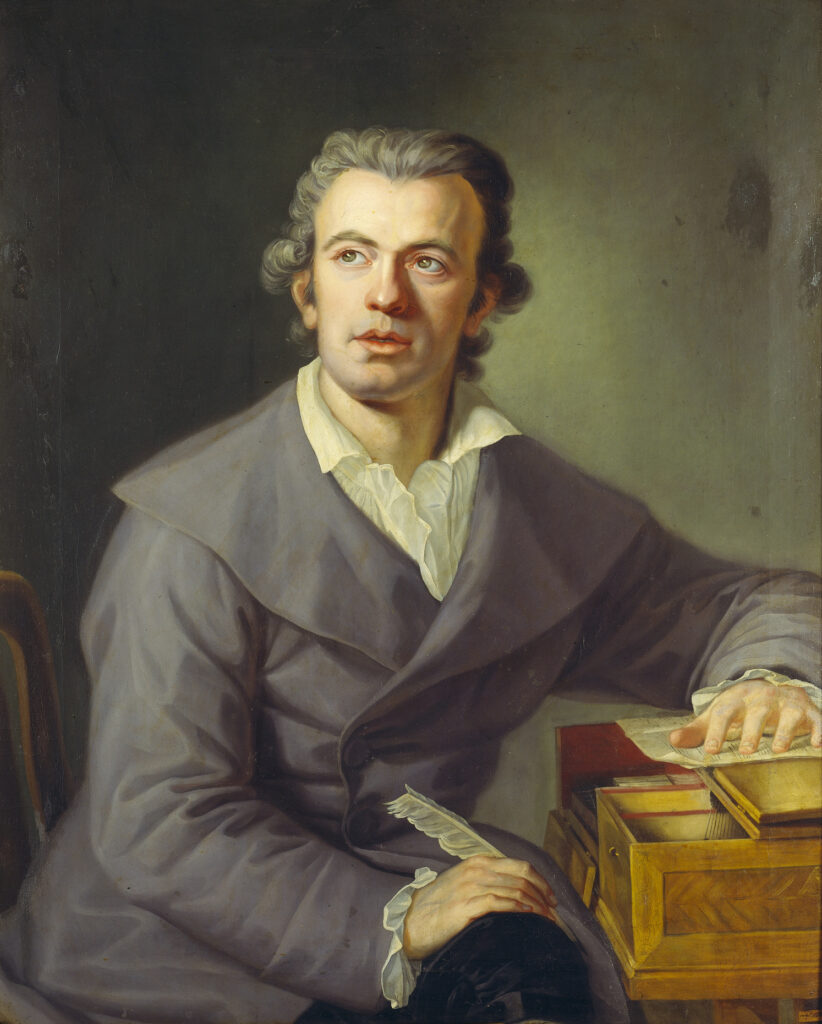The court kapellmeister to the prince-elector of Saxony, Johann Gottlieb Naumann (1741–1801), was not only an important figure in the cultural life of Dresden at the end of the 18th century; during his lifetime, he was highly regarded not only in Germany but also abroad. His story reads like a fairy tale: the son of a small farmer with no land of his own, born in the present-day Dresden suburb of Blasewitz, he left his hometown in 1757 to pursue his artistic education in Italy. After his first successes as a composer, he returned to his native Saxony in 1764, where he took a position as a clerical composer to the prince-elector of Saxony at the court of Dresden. His fame began to rise significantly after his appointment as court kapellmeister in 1776 and his participation in the plans of King Gustav III of Sweden and King Christian VII of Denmark to reform opera.
In addition to operas and sacred music, Naumann also composed songs (more than 300), including setting Masonic texts (over 70 songs). His high popularity is evidenced by his numerous publications in 18th and 19th century song collections.
Johann Gottlieb Naumann became a Johannite in 1774 when he was admitted to the Dresden French-speaking lodge Aux vrais amis, part of the Zu wahren vereinigten Freunden lodge. On 17 December 1774, he was already promoted from apprentice to journeyman and further to master in 1776. Three years later, he was promoted to Scottish Master and between 1780 and 1782 he held the post of Master of Ceremonies. The cessation of all activity of the Dresden Lodge in 1790 brought his Masonic involvement to a standstill from which it never recovered.
The opera Osiris, which libretto was written by the Dresden court poet Caterino Mazzolà, is one of the stage-works written for the Dresden court. The opera was performed on the wedding of the Saxon Prince Anton Clemens Theodor von Sachsen to Marie Caroline Antoinette of Sardinia on 27 October 1781 in the Little Electoral Theatre in Dresden. The important Naumann biographer Richard Engländer has long argued that the opera is “…a grand confession of Freemasonry”. But research in recent years has come to different conclusions. According to Florian Ebeling, a philosopher and Egyptologist who also works on the history of opera, the libretto for Osiris is a mythologically exaggerated reflection of a real wedding couple and differs significantly from Mozart’s Zauberflöte, the par excellence Masonic opera. The scenic images of mythical Egypt, the constellation of characters, the characterisation of the couple at the centre of the action and the various plot elements contained numerous similarities but were not often of Masonic origin. On the other hand, it is certainly difficult to separate references to Freemasonry. However, the libretto for Osiris may have been the inspiration for Mozart’s Zauberflöte (which premiered 10 years later), although it was not a decisive source.
On the contrary, Klaus Pietschmann says that Osiris is “… a consistent, Masonic lesson […] the full meaning of which is accessible only to the initiated”. His claim is based on parallels between opera and Masonic ritual, while the “borrowed” references to Masonic music are not made explicit.
Although the Freemasonry ideas and principles fit culturally and historically into the setting of the story of the ancient Egyptian King Osiris, conflicting evaluations show that there is reason to doubt the fundamental Masonic idea that would permeate the work.
Besides, Osiris was extremely important for the development of Naumann’s operatic work in terms of form, singing style and instrumental technique. To be more specific, the overture is the first instance of Naumann being influenced by French-style opera. He then composed his subsequent operas in a similar style.
Aria Se mai vedi il mio tesoro comes from the seventh scene of the first act of the opera Suleiman, composed on the carnival in Venice in 1773 to a libretto by an unknown author. The opera is one of the so-called seria operas that Naumann composed during his third stay in Italy. The aria, following its success in Venice, was published in print and further spread thanks to numerous manuscript copies.
Sinfonia in D is an ouverture to Naumann’s opera Amphion with a Swedish libretto, which premiered on 26 January 1778 in Stockholm. From July 1777 Naumann stayed in Sweden at the instigation of King Gustav III of Sweden to rebuild the court orchestra and perform his own works. The overture is composed in the style of a three-part Neapolitan opera sinfonia.
Offertorium Lauda Sion Salvatorem is one of the Catholic offertories composed by the Protestant Naumann. It was written in 1796 for Dresden’s Holy Trinity Cathedral and was one of the few works of church music with Latin text by the composer to appear in print. Based on this printed edition, more than two dozen transcriptions can be found in various German, Austrian and Czech libraries.
Author: Dr. Kornél Magvas



